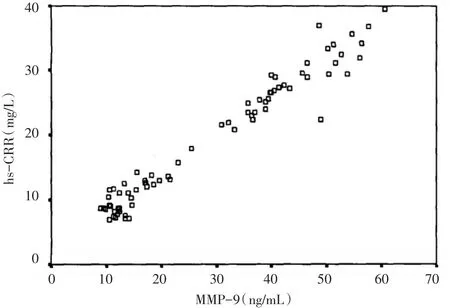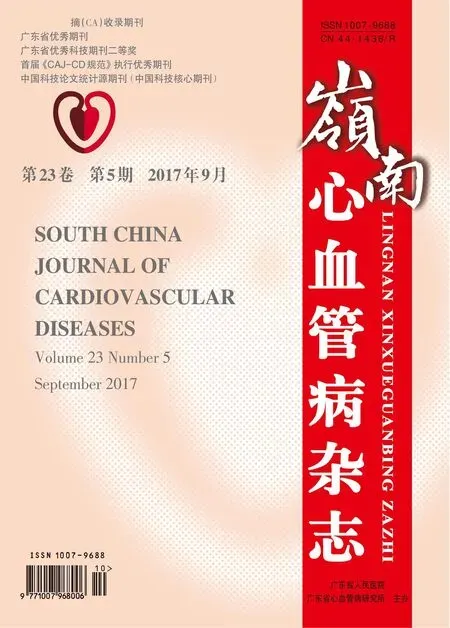冠状动脉粥样硬化斑块稳定性与血清基质金属蛋白酶-9及超敏C反应蛋白浓度的关系△
宋 颖,李晓燕
(济南军区总医院,济南250031)
·实验研究·
冠状动脉粥样硬化斑块稳定性与血清基质金属蛋白酶-9及超敏C反应蛋白浓度的关系△
宋 颖,李晓燕
(济南军区总医院,济南250031)
目的 探讨冠状动脉粥样硬化(atherosclerosis,AS)斑块稳定性与血清基质金属蛋白酶-9(matrix metallo⁃proteinase-9,MMP-9)及超敏C反应蛋白(high sensitivity C-reactive protein,hs-CRP)浓度的关系。方法 按照随机分组方法将56只大白兔划分为2组:A组为AS研究组40只,A组分为A1亚组(斑块破裂组)、A2亚组(斑块未破裂组);B组为参照组16只。A组采用(标准颗粒+1%胆固醇)进行喂养+球囊损伤,B组采用标准颗粒喂养。在研究期间,动态监测A、B两组血清MMP-9和hs-CRP浓度及血脂的变化情况。结果 研究期间,B组兔的体质量与A1、A2亚组比较,差异有统计学意义(P<0.05)。实验开始、实验第14周末,B组血脂指标变化不明显,A2和A1亚组的血脂指标由实验开始时到实验第14周末呈上升趋势;实验第14周末,B组与A1、A2亚组的血脂浓度比较,差异均有统计学意义(P<0.01);但是A2亚组和A1亚组血脂浓度比较,差异无统计学意义(P>0.05)。在第4周时,B组与A1亚组、A2亚组的血清MMP-9和hs-CRP浓度比较,差异有统计学意义(P<0.01)。在第10周时,B组、A2亚组和A1亚组的血清MMP-9和hs-CRP浓度比较,差异有统计学意义(P<0.01);A1亚组血清MMP-9和hs-CRP浓度高于A2亚组,且差异有统计学意义(P<0.01)。在第14周时,A1亚组和A2亚组的血清MMP-9和hs-CRP浓度均高于B组,差异有统计学意义(P<0.01);A1亚组血清MMP-9和hs-CRP浓度高于A2亚组,且差异有统计学意义(P<0.01)。实验过程中A1、A2两亚组的血清MMP-9、hs-CRP浓度均呈现升高趋势(P<0.01)。实验兔血清MMP-9浓度和hs-CRP浓度之间为正相关关系(r=0.967,P=0.001)。结论MMP-9和hs-CRP呈正相关关系,且两者的浓度与AS斑块稳定性密切相关,斑块越不稳定,MMP-9和hs-CRP的浓度越高。
基质金属蛋白酶-9;超敏C-反应蛋白;动脉粥样硬化斑块稳定性
随着人们生活水平的提高,其饮食习惯发生了很大变化,随之而来的健康问题越来越多,其中动脉粥样硬化(atherosclerosis,AS)疾病就是常见的一种,它是一种慢性炎症性疾病,主要特点就是造成“稳定斑块”向“不稳定斑块”转变,最终造成如急性心脑血管疾病等严重的后果[1]。本研究探讨AS斑块稳定性与血清基质金属蛋白酶-9(matrix me⁃talloproteinase-9,MMP-9)及超敏C反应蛋白(high sensitivity C-reactive protein,hs-CRP)浓度的关系。
1 材料与方法
1.1 材料
按照随机分组方法将56只大白兔划分为2组:A组为AS研究组40只,B组为参照组16只。A组采用(标准颗粒+1%胆固醇)进行喂养+球囊损伤,标准颗粒+1%胆固醇进行喂养14周;球囊损伤采用腹主动脉内膜方案。B组采用标准颗粒喂养。14周后采用组胺触发的方法促使AS斑块破裂,将A组40只兔子杀死后,观察AS斑块破裂情况,将斑块破裂的划入破裂组,即A1亚组,未破裂的划入未破裂组,即为A2亚组。
1.2 药物触发
根据Constantinides等对实验兔药物触发方法:在实验14周后,对A组实验兔在杀死前的24 h和48 h分别注射0.15 mg/kg的中国斑点蝰蛇毒,30 min后再注射0.02 mg/kg的组胺。
1.3 方法
喂养方法:所有实验兔实行单笼饲养,每天密切观察它们的进食情况,并每周记录其体质量和定期检查。血清炎性物质检测:分别在实验开始前、第4周、第10周和第14周对所有实验兔抽取静脉血,并采用酶联免疫吸附试验(ELISA)方法检测血清MMP-9和hs-CRP的浓度。血液生化指标检测:分别在实验开始前、第4周、第10周和药物触发前对所有实验兔进行血液生化检测。检测血清三酰甘油(triacylglycerol,TG),总胆固醇(total cholesterol,TC),低密度脂蛋白胆固醇(low density lipoprotein-cholesterol,LDL-C),高密度脂蛋白胆固醇(high density lipoprotein-cholesterol,HDL-C)浓度。
1.4 统计学分析
采用统计软件SPSS 19.0对所有数据进行分析。计量资料以(±s)表示,采用LSD-t检验及采用Oneway ANOVA方差分析检验。两变量的相关分析采用Bivariate过程的Pearson等级相关法。以P<0.05为差异有统计学意义。
2 结果
2.1 实验过程中 3组兔的体质量、血脂浓度比较
如表1所示,实验过程中B组兔的体质量与A1亚组、A2亚组比较,差异有统计学意义(P<0.01);A1亚组和A2亚组间兔的体质量比较,差异无统计学意义(P>0.05)。实验开始、实验第14周末,B组血脂指标变化不明显,A2亚组和A1亚组的血脂指标由实验开始时到实验第14周末呈上升趋势;实验开始时3组血脂指标比较,差异无统计学意义(P>0.05);实验第14周末,B组血脂指标与A1亚组、A2亚组比较,差异均有统计学意义(P<0.01),但是A2亚组和A1亚组间比较,差异无统计学意义(P>0.05),详见表2。
2.2 各时间点 3组血清基质金属蛋白酶- 9及超敏 C反应蛋白浓度比较
在实验开始时B组、A2亚组、A1亚组血清MMP-9和hs-CRP浓度比较,差异无统计学意义(P>0.05)。在第4周时,B组与A2亚组、A1亚组血清MMP-9和hs-CRP浓度比较,差异有统计学意义(P<0.01);A1亚组血清MMP-9和hs-CRP浓度和A2亚组对比,差异没有统计学意义(P>0.05)。在第10周时,B组、A2亚组和A1亚组血清MMP-9和hs-CRP浓度比较,差异有统计学意义(P<0.01);A1亚组血清MMP-9和hs-CRP浓度高于A2亚组,且差异有统计学意义(P<0.01)。在第14周时A1和A2亚组的MMP-9和hs-CRP浓度均高于B组,差异有统计学意义(P<0.01);A1亚组的MMP-9和hs-CRP浓度高于A2亚组,且差异有统计学意义(P<0.01)。各时间点3组血清MMP-9和hs-CRP浓度比较,详见表3。A1亚组和A2亚组血清MMP-9、hs-CRP浓度从实验开始至第14周呈逐渐升高趋势,且差异有统计学意义(P>0.05)。
表1 实验过程中3组兔的体质量比较 [kg,±s]

表1 实验过程中3组兔的体质量比较 [kg,±s]
注:与B组比较,**P<0.01
组别B组A2亚组A1亚组n 16 18 22实验开始时1.80±0.22 2.11±0.18**2.22±0.34**第14周末2.18±0.17 2.59±0.23**2.62±0.22**
表2 实验开始时及第14周末3组的血脂指标比较 [mmol/L,±s]

表2 实验开始时及第14周末3组的血脂指标比较 [mmol/L,±s]
注:与B组比较,**P<0.01;与实验开始时同组比较,1)*P<0.05
时间n实验开始时实验第14周末组别B组A2亚组A1亚组B组A2亚组A1亚组16 18 22 16 18 22 TG 0.75±0.31 0.48±0.18 0.48±0.18 0.68±0.06 1.13±0.09**,1)*1.11±0.80**,1)*TC 1.07±0.06 1.04±0.78 1.08±0.75 1.12±0.13 24.81±2.50**,1)*23.24±3.01**,1)*HDL-C 0.39±0.21 0.42±0.27 0.41±0.22 0.49±0.41 1.10±0.15**,1)*1.04±0.14**,1)*LDL-C 0.44±0.32 0.38±0.03 0.37±0.26 0.50±0.05 20.10±2.70**,1)*19.69±1.28**,1)*
表3 各时间点3组血清MMP-9和hs-CRP浓度比较 [mmol/L,±s]

表3 各时间点3组血清MMP-9和hs-CRP浓度比较 [mmol/L,±s]
注:与B组同项比较,**P<0.01;与A2亚组同项比较,1)**P<0.01;与实验开始时同组比较,aP<0.05;与第4周同组比较,bP<0.05;与第10周同组比较,cP<0.05
指n MMP-9(ng/mL)hs-CRP(mg/L)组别B组A2亚组A1亚组B组A2亚组A1亚组16 18 22 16 18 22实验开始时11.94±1.91 11.43±1.25 11.54±1.80 8.02±0.34 8.12±0.52 8.06±0.74第4周11.03±2.70 14.56±2.46**,a 17.22±3.95**,a 8.10±0.46 12.03±1.15**,a 12.56±1.33**,a第10周10.97±2.86 33.65±4.15**,a,b 43.89±7.24**,1)**,a,b 8.44±0.83 21.84±1.86**,a,b 26.95±3.49**,1)**,a,b第14周10.84±1.65 40.48±2.99**,a,b,c 51.98±5.60**,1)**,a,b,c 8.23±0.67 26.57±1.40**,a,b,c 33.78±3.19**,1)**,a,b,c
2.3 相关分析结果
血清MMP-9和hs-CRP之间呈正相关关系(r=0.967,P=0.001),见图1。
3 讨论
由于我国社会、经济的快速发展,人们的生活水平得到了很大提高,人们的生活方式和饮食习惯也发生了很大变化,我国的AS患者也随之增多,并有逐年上升的趋势[2]。AS对患者造成最主要的伤害是AS斑块由“稳定”转变为“不稳定”,进而造成一系列的疾病发生,如脑梗死、心脑血管疾病等[3-4]。
MMPs是一类以锌离子为辅助因子的蛋白酶超家族,其主要作用是降解细胞外基质成分,在组织重构过程中起着重要的作用[5]。MMPs的种类很多,有20多种,MMP-9是其中之一,其为明胶酶,如果Ⅳ型、Ⅴ型胶原及明胶被降解,可能造成AS的发生及发展[6]。Galis等发现,与野生型小鼠相比,MMP-9基因缺陷小鼠的血管平滑肌细胞迁移活性和胶原收缩能力均降低,表明MMP-9参与血管壁的基质降解和重构。相关研究表明,和正常动脉壁相比,AS斑块内的MMP-2和MMP-9浓度升高、活性增强,这也预示着MMP-9通过降解细胞外基质参与AS的发生及发展[7]。相关的实验报道也表明,MMP-9浓度和活性强度与斑块的不稳定有很大的关系[8]。Manginas等[9]相关报道称,细胞外基质降解和AS斑块发生破裂都是由MMP-9浓度升高引起。本研究显示,AS斑块形成的第4周、10周及14周末,A1和A2亚组的血清MMP-9浓度在呈上升趋势,A1和A2亚组与B组相比,MMP-9浓度较高,差异有统计学意义(P<0.05)。

图1 血清MMP-9和hs-CRP之间相关性散点图
AS是一种慢性炎症性疾病,可以通过对血清中的炎症标志物浓度的检测来看出AS斑块的发展程度[9]。正常情况下,C反应蛋白在血清中浓度很低,当在特异或者非特异性炎症发生时,其浓度会增加,因此,其已经在临床中作为炎症性疾病的检测指标[10]。hs-CRP是最敏感的检测慢性炎症反应的指标之一[11]。相关研究显示,AS的发生和发展过程中,hs-CRP发挥了很大的作用,增加了AS斑块的不稳定性[12]。有研究报道称,和稳定型心绞痛患者相比,急性冠脉综合症患者的C反应蛋白浓度明显增加,表明C反应蛋白浓度升高时导致AS斑块破裂,而两者倒置。国内、外研究表明,血清hs-CRP浓度的升高与斑块的炎症反应有关,血清hs-CRP浓度高低可以反映斑块的稳定性[9]。本研究结果显示,兔AS斑块形成过程中的第4、10周和14周末,其hs-CRP浓度呈上升趋势,A1和A2亚组与B组相比,hs-CRP浓度较高,差异有统计学意义(P<0.01)。
本研究相关分析结果显示,MMP-9和hs-CRP呈正相关关系,且两者的浓度与AS斑块稳定性密切相关,斑块越不稳定,MMP-9和hs-CRP的浓度越高。
[1]MORENO P R,PURUSHOTHAMAN K R,FUSTER V,et al.Plaque neovaseularization is inereased in ruptured atheroselerotic lesions of human aorta:implieations for plaque vulnerability[J].Cireulation,2004,110(14):2032-2038.
[2] 韦立新.不稳定斑块破裂的形态学及发生机制的病理学研究进展[J].国外医学(生理、病理科学与临床分册),2003,23(5):441-443.
[3] VISSE R,NAGASE H.Matrix metalloproteinase and tissue in⁃hibiters of metalloproteinase:strueture,funetion,and biochem⁃istry[J].Cire Res,2003,92(8):827-839.
[4]MORENO P R,PURUSHOTHAMAN K R,ZIAS E,et al.Neovaseularization in human atheroselerosis[J].Curr Mol Med,2006,6(5):457-447.
[5]VIRMANI R,KOLODGIE F D,BURKE A P,et al.Atherosel⁃erotic plaque progression and vulnerability to rupture:angiogen⁃esis as a source of intraplaque hemorrhage[J].Arterioseler Thromb Vasc Biol,2005,25(10):2054-2061.
[6] PIAO M,TOKUNAGA O.Significant expression of endoglin(CD105),TGF beta-l and GF beta R-2 in the atheroselerotic aorta:an immunohistological study[J].J Atheroscler Thromb,2006,13(2):82-89.
[7] MORENO P R,PURUSHOTHAMAN K R,FUSTER V,et al.Plaque neovascularization is increased in ruptured atherosclero⁃tielesions of human aorta:implications for plaque vulnerability[J].Circulation,2004,110(14):2032-2038.
[8]DOYLE B,CAPLICE N.Plaque neovascularization and antian⁃giogenic therapy for atherosclerosis[J].J Am Coll Cardiol,2007,49(21):2102-104.
[9]MANGINAS A,BEI E,CHAIDAROGLOU A,et al.Peripher⁃al levels of matrix metallo proteinase-9,interleukin-6,and C-reactive protein are elevated in patients with acute coronary syn⁃dromes:correlations with serum troponin I[J].Clin Cardial,2005,28(4):182-186.
[10] BRUNETTI N D,TROEEOLI R,CORREALE M,et al.C-reac⁃tive protein in patients with acute coronary syndrome:correlation with diagnosis,myocardial damag,ejection fraction and angio⁃graphic findings[J].Int J Cardiol,2006,109(2):248-256.
[11] CUI S,LU S Z,CHEN Y D,et al.Relationshipe between in⁃travascular ultrasound imaging features of coronary plaques and soluble CD105 level in patients with coronary heart disease[J].China Med J(Engl),2007,120(7):595-597.
[12] VISSE R,NAGASE H.Matrix metalloproteinase and tissue in⁃hibiters of metalloproteinase:structure,function,and biochemis⁃try[J].Cire Res,2003,92(8):827-839.
Relationships between coronary atherosclerotic plaque stability with serum concentrations of matrix metalloproteinase-9 and high sensitivity C-reactive protein
SONG Ying,LI Xiao-yan
(General Hospital of Jinan Military Area,Jinan 250031,China)
ObjectivesTo evaluate and the relationships between coronary atherosclerosis(AS)plaque stability with serum concentrations of matrix metalloproteinase-9(MMP-9)and high sensitivity C-reactive protein(hs-CRP).MethodsAccording to the random grouping method,56 rabbits were divided into two groups:40 rabbits were in A group[including A1 subgroup(plaque broken)and A2 subgroup(plaque not broken)]which was the AS study group,16 rabbits were in B group which was a reference group.Rabbits were treated with standard particle feeding+1%cholesterol+balloon injury in A group and rabbits were treated with standard particle feeding in B group.Serum con⁃centrations of MMP-9,hs-CRP and blood lipids were dynamicly monitored among the 3 groups.ResultsDifferences of body weight of rabbits between B group with A1 subgroup and A2 subgroup were significantly different during the study(P<0.05).Blood lipids concentrations in B group were not significantly different but they were uptrend in A1 sub⁃group and A2 subgroup from the beginning to the 14thweek in this study.Blood lipids concentrations in B group were significantly different with those of A1 subgroup and A2 subgroup(P<0.05)at the 14thweek in this study,but they had no statistic difference between A1 subgroup and A2 subgroup(P>0.05).Serum concentrations of MMP-9 and hs-CRPin B group were significantly different compared with those in A1 subgroup and A2 subgroup in the 4thweek(P<0.05).Differences of concentrations of MMP-9 and hs-CRP among B group,A1 subgroup and A2 subgroup were significant at the 10thweek(P<0.01),and concentrations of MMP-9 and hs-CRP in A1 subgroup were obvious higher than those in A2 subgroup(P<0.01).Concentrations of MMP-9 and hs-CRP in A1 subgroup and A2 subgroup were significantly higher than those in B group at 14thweek(P<0.01),and those in A1 subgroup were obviously higher than those in A2 subgroup(P<0.01).Concentrations of MMP-9 and hs-CRP in A1 subgroup and A2 subgroup were uptrend during this study.Concentration of MMP-9 positively related with concentration of hs-CRP(r=0.967,P=0.001).Conclusions Concentration of MMP-9 positively relates with concentration of hs-CRP,and they both closely relate to AS plaque sta⁃bility.The higher the concentrations of MMP-9 and hs-CRP are,the the more unstable the plaques are.
matrix metalloproteinase-9;high-sensitivity C-reactive protein;atherosclerotic plaque stability
R541.4
A
1007-9688(2017)05-0610-04
10.3969/j.issn.1007-9688.2017.05.28
贵州省科技计划课题(项目编号:黔科合SY字【2010】)两院合作项目;山东省自然科学基金项目(项目编号:ZR2010HM202)。
宋颖(1983-),女,住院医师,研究方向为老年病学。
2016-07-14)

